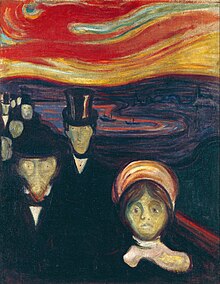
Back Angs Afrikaans قلق Arabic উদ্বিগ্নতা Assamese Ansiedá AST Narahatlıq Azerbaijani تشویش AZB Nerėms BAT-SMG Трывога Byelorussian Трывога BE-X-OLD Тревожност Bulgarian

| Part of a series on |
| Emotions |
|---|
  |
Anxiety is an emotion characterised by an unpleasant state of inner turmoil and includes feelings of dread over anticipated events.[1][2][3] Anxiety is different from fear in that fear is defined as the emotional response to a present threat, whereas anxiety is the anticipation of a future one.[4] It is often accompanied by nervous behavior such as pacing back and forth, somatic complaints, and rumination.[5]
Anxiety is a feeling of uneasiness and worry, usually generalized and unfocused as an overreaction to a situation that is only subjectively seen as menacing.[6] It is often accompanied by muscular tension,[7] restlessness, fatigue, inability to catch one's breath, tightness in the abdominal region, nausea, and problems in concentration. Anxiety is closely related to fear,[3] which is a response to a real or perceived immediate threat (fight-or-flight response); anxiety involves the expectation of a future threat including dread.[7] People facing anxiety may withdraw from situations which have provoked anxiety in the past.[8]
The emotion of anxiety can persist beyond the developmentally appropriate time-periods in response to specific events, and thus turning into one of the multiple anxiety disorders (e.g. generalized anxiety disorder, panic disorder).[9][10] The difference between anxiety disorder (as mental disorder) and anxiety (as normal emotion), is that people with an anxiety disorder experience anxiety excessively or persistently during approximately 6 months, or even during shorter time-periods in children.[7] Anxiety disorders are among the most persistent mental problems and often last decades.[11] Anxiety can also be experienced within other mental disorders, e.g., obsessive-compulsive disorder, post-traumatic stress disorder.[12][13]
- ^ Davison GC (2008). Abnormal Psychology. Toronto: Veronica Visentin. p. 154. ISBN 978-0-470-84072-6.
- ^ Miceli M, Castelfranchi C (2014-11-27). Expectancy and emotion. Oxford: Oxford University Press. ISBN 978-0-19-150927-8. Archived from the original on 2023-01-17. Retrieved 2022-05-09.
- ^ a b Chand SP, Marwaha R (2022). "Anxiety". StatPearls. Treasure Island (FL): StatPearls Publishing. PMID 29262212. Archived from the original on 2022-06-21. Retrieved 2022-12-15.
Anxiety is linked to fear and manifests as a future-oriented mood state that consists of a complex cognitive, affective, physiological, and behavioral response system associated with preparation for the anticipated events or circumstances perceived as threatening.
- ^ Crocq MA (September 2015). "A history of anxiety: from Hippocrates to DSM". Dialogues in Clinical Neuroscience. 17 (3): 319–325. doi:10.31887/DCNS.2015.17.3/macrocq. PMC 4610616. PMID 26487812.
- ^ Seligman ME, Walker EF, Rosenhan DL. Abnormal psychology (4th ed.). New York: W.W. Norton & Company.[page needed]
- ^ Bouras N, Holt G (2007). Psychiatric and Behavioral Disorders in Intellectual and Developmental Disabilities (2nd ed.). Cambridge University Press. ISBN 978-1-139-46130-6. Archived from the original on 2023-01-17. Retrieved 2018-11-22.[page needed]
- ^ a b c American Psychiatric Association (2013). Diagnostic and Statistical Manual of Mental Disorders (5th ed.). Arlington, VA: American Psychiatric Publishing. p. 189. ISBN 978-0-89042-555-8.
- ^ Barker P (2003). Psychiatric and Mental Health Nursing: The Craft of Caring. London: Edward Arnold. ISBN 978-0-340-81026-2.[page needed]
- ^ Robinson OJ, Pike AC, Cornwell B, Grillon C (December 2019). "The translational neural circuitry of anxiety". Journal of Neurology, Neurosurgery, and Psychiatry. 90 (12). BMJ: 1353–1360. doi:10.1136/jnnp-2019-321400. PMID 31256001. S2CID 195758112.
Anxiety is an adaptive response that promotes harm avoidance, but at the same time excessive anxiety constitutes the most common psychiatric complaint.
- ^ Evans DL, Foa EB, Gur RE, Hendin H, O'Brien CP, Seligman ME, Walsh BT, eds. (2005). Treating and preventing adolescent mental health disorders: what we know and what we don't know. A research agenda for improving the mental health of our youth. New York: Oxford University Press. doi:10.1093/9780195173642.001.0001. ISBN 978-0-19-517364-2. OCLC 56324679. Archived from the original on 2021-12-16. Retrieved 2021-06-02.
- ^ Hovenkamp-Hermelink JH, Jeronimus BF, Myroniuk S, Riese H, Schoevers RA (May 2021). "Predictors of persistence of anxiety disorders across the lifespan: a systematic review" (PDF). The Lancet. Psychiatry. 8 (5): 428–443. doi:10.1016/S2215-0366(20)30433-8. PMID 33581052. S2CID 231919782. Archived (PDF) from the original on 2023-04-05. Retrieved 2023-04-05.
- ^ Marras A, Fineberg N, Pallanti S (August 2016). "Obsessive compulsive and related disorders: comparing DSM-5 and ICD-11". CNS Spectrums. 21 (4): 324–333. doi:10.1017/S1092852916000110. PMID 27401060. S2CID 13129793.
- ^ World Health Organization (2023). International Classification of Diseases, eleventh revision – ICD-11. Genova – icd.who.int.